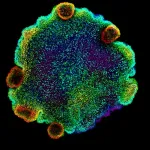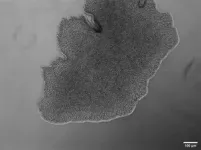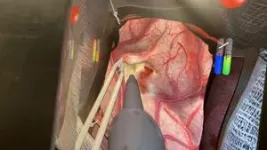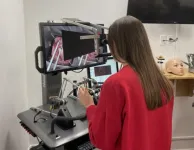(Press-News.org) A study in the journal Cell sheds new light on the evolution of neurons, focusing on the placozoans, a millimetre-sized marine animal. Researchers at the Centre for Genomic Regulation in Barcelona find evidence that specialized secretory cells found in these unique and ancient creatures may have given rise to neurons in more complex animals.
Placozoans are tiny animals, around the size of a large grain of sand, which graze on algae and microbes living on the surface of rocks and other substrates found in shallow, warm seas. The blob-like and pancake-shaped creatures are so simple that they live without any body parts or organs. These animals, thought to have first appeared on Earth around 800 million years ago, are one of the five main lineages of animals alongside Ctenophora (comb jellies), Porifera (sponges), Cnidaria (corals, sea anemones and jellyfish) and Bilateria (all other animals).
The sea creatures coordinate their behaviour thanks to peptidergic cells, special types of cells that release small peptides which can direct the animal’s movement or feeding. Driven by the intrigue of the origin of these cells, the authors of the study employed an array of molecular techniques and computational models to understand how placozoan cell types evolved and piece together how our ancient ancestors might have looked and functioned.
Reconstructing ancient cell types
The researchers first made a map of all the different placozoan cell types, annotating their characteristics across four different species. Each cell type has a specialised role which comes from certain sets of genes. The maps or ‘cell atlases’ allowed researchers to chart clusters or ‘modules’ of these genes. They then created a map of the regulatory regions in DNA that control these gene modules, revealing a clear picture about what each cell does and how they work together. Finally, they carried out cross-species comparisons to reconstruct how the cell types evolved.
The research showed that the main nine cell types in placozoans appear to be connected by many "in-between" cell types which change from one type to another. The cells grow and divide, maintaining the delicate balance of cell types required for the animal to move and eat. The researchers also found fourteen different types of peptidergic cells, but these were different to all other cells, showing no in-between types or any signs of growth or division.
Surprisingly, the peptidergic cells shared many similarities to neurons – a cell type which didn’t appear until many millions of years later in more advanced animals such as and bilateria. Cross-species analyses revealed these similarities are unique to placozoans and do not appear in other early-branching animals such as sponges or comb jellies (ctenophores).
Evolutionary stepping stones
The similarities between peptidergic cells and neurons were threefold. First, the researchers found that these placozoan cells differentiate from a population of progenitor epithelial cells via developmental signals that resemble neurogenesis, the process by which new neurons are formed, in cnidaria and bilateria.
Second, they found that peptidergic cells have many gene modules required to build the part of a neuron which can send out a message (the pre-synaptic scaffold). However, these cells are far from being a true neuron, as they lack the components for the receiving end of a neuronal message (post-synaptic) or the components required for conducting electrical signals.
Finally, the authors used deep learning techniques to show that placozoan cell types communicate with each other using a system in cells where specific proteins, called GPCRs (G-protein coupled receptors), detect outside signals and start a series of reactions inside the cell. These outside signals are mediated by neuropeptides, chemical messengers used by neurons in many different physiological processes.
“We were astounded by the parallels," says Dr. Sebastián R. Najle, co-first author of the study and postdoctoral researcher at the Centre for Genomic Regulation. "The placozoan peptidergic cells have many similarities to primitive neuronal cells, even if they aren't quite there yet. It's like looking at an evolutionary stepping stone."
The dawn of the neuron
The study demonstrates that the building blocks of the neuron were forming 800 million years ago in ancestral animals grazing inconspicuously in the shallow seas of ancient Earth. From an evolutionary point of view, early neurons might have started as something like the peptidergic secretory cells of today’s placozoans. These cells communicated using neuropeptides, but eventually gained new gene modules which enabled cells to create post-synaptic scaffolds, form axons and dendrites and create ion channels that generate fast electrical signals – innovations which were critical for the dawn of the neuron around one hundred million years after the ancestors of placozoans first appeared on Earth.
However, the complete evolutionary story of nerve systems is still to be told. The first modern neuron is thought to have originated in the common ancestor of cnidarians and bilaterians around 650 million years ago. And yet, neuronal-like cells exist in ctenophores, although they have important structural differences and lack the expression of most genes found in modern neurons. The presence of some of these neuronal genes in the cells of placozoans and their absence in ctenophores raises fresh questions about the evolutionary trajectory of neurons.
“Placozoans lack neurons, but we’ve now found striking molecular similarities with our neural cells. Ctenophores have neural nets, with key differences and similarities with our own. Did neurons evolve once and then diverge, or more than once, in parallel? Are they a mosaic, where each piece has a different origin? These are open questions that remain to be addressed”, says Dr. Xavier Grau-Bové, co-first author of the study and postdoctoral researcher at the Centre for Genomic Regulation.
The authors of the study believe that, as researchers around the world continue to sequence high-quality genomes from diverse species, the origins of neurons and the evolution of other cell types will become increasingly clear. “Cells are the fundamental units of life, so understanding how they come into being or change over time is key to explain the evolutionary story of life. Placozoans, ctenophores, sponges and other non-traditional model animals harbour secrets that we are only just beginning to unlock,” concludes ICREA Research Professor Arnau Sebé-Pedros, corresponding author of the study and Junior Group Leader at the Centre for Genomic Regulation.
END
Tiny sea creatures reveal the ancient origins of neurons
Our brain cell components were forming in shallow seas around 800 million years ago
2023-09-19
ELSE PRESS RELEASES FROM THIS DATE:
Argyle study reveals crucial third clue to finding new diamond deposits
2023-09-19
Curtin University researchers studying diamond-rich rocks from Western Australia’s Argyle volcano have identified the missing third key ingredient needed to bring valuable pink diamonds to the Earth’s surface where they can be mined, which could greatly help in the global hunt for new deposits.
While it is known that for diamonds to form there needs to be carbon deep in the Earth, and for these diamonds to turn pink they must be subjected to forces from colliding tectonic plates, the new study has found the third ingredient needed for the presence of pink diamonds at surface ...
Assessing unintended consequences in AI-based neurosurgical training
2023-09-19
Virtual reality simulators can help learners improve their technical skills faster and with no risk to patients. In the field of neurosurgery, they allow medical students to practice complex operations before using a scalpel on a real patient. When combined with artificial intelligence, these tutoring systems can offer tailored feedback like a human instructor, identifying areas where the students need to improve and making suggestions on how to achieve expert performance.
A new study from the Neurosurgical Simulation and Artificial Intelligence Learning Centre at The Neuro (Montreal Neurological Institute-Hospital) of McGill University, ...
USPSTF recommendation on screening for hypertensive disorders of pregnancy
2023-09-19
Bottom Line: The U.S. Preventive Services Task Force (USPSTF) recommends screening for hypertensive disorders in pregnant persons with blood pressure measurements throughout pregnancy. Hypertensive disorders of pregnancy are among the leading causes of maternal morbidity and mortality in the U.S. The rate has been increasing from approximately 500 cases per 10,000 deliveries in 1993 to 1,021 cases per 10,000 deliveries in 2016 to 2017. The USPSTF routinely makes recommendations about the effectiveness of preventive care services and this recommendation is consistent with its 2017 recommendation statement.
To access the embargoed study: Visit our For The Media website ...
Deep learning reveals valuable clues about kidney cancer in pathology slides
2023-09-19
A team of Dana-Farber researchers has identified a potential new way to assess clinically valuable features of clear cell renal cell carcinoma (ccRCC), a form of kidney cancer, using image processing with deep learning. Their AI-based assessment tool evaluates two-dimensional pictures of a tumor sample on a pathology slide and identifies previously underappreciated features, such as tumor microheterogeneity, that could help predict whether a tumor will respond to immunotherapy.
Their results suggest that ...
Poor oral health could lessen survival from head and neck cancer
2023-09-19
An international study has revealed strong associations between oral health and survival among people diagnosed with head and neck cancer. Specifically, better oral health, as evidenced by the number of natural teeth and dental visits prior to the time of diagnosis, was associated with increased survival. Importantly, those who had more frequent dental visits were more likely to have their cancer diagnosed at an earlier, and less deadly, stage of the disease than those who had few or no dental visits.
The study, by researchers at UNC Lineberger ...
Interventions for physical capacity and quality of life in adults with post–COVID-19 condition
2023-09-19
About The Study: The findings of this systematic review and meta-analysis suggest that rehabilitation interventions in adults with post–COVID-19 condition are associated with improvements in functional exercise capacity, dyspnea, and quality of life, with a high probability of improvement compared with the current standard care. The certainty of evidence was moderate for functional exercise capacity and quality of life and low for other outcomes.
Authors: Dimitra V. Pouliopoulou, M.Sc., of Western University in London, Ontario, Canada, is the corresponding author.
To access the embargoed study: Visit our For The Media website at this link ...
Premenstrual disorders, timing of menopause, and severity of vasomotor symptoms
2023-09-19
About The Study: In this study of 3,635 female participants in the U.S., premenstrual disorders (PMDs) were associated with increased risks of early menopause and moderate or severe vasomotor symptoms (VMS). PMDs may be indicative of underlying physiology linked to early menopause and VMS, suggesting a phenotype observable during the reproductive years that may allow clinicians to target women at risk of earlier menopause and subsequent health risks later in the life course.
Authors: Yihui Yang, M.P.H., and Donghao Lu, M.D., Ph.D., of the Karolinska Institutet in Stockholm, Sweden are the corresponding authors.
To ...
Study finds two antibiotics for children with sinusitis equally effective, but one had fewer side effects
2023-09-19
Brigham researchers found that patients prescribed amoxicillin-clavulanate had higher rates of gastrointestinal symptoms and yeast infections than those prescribed amoxicillin
Acute sinusitis is one of the most common causes for children to be put on antibiotic medications, with patients in the United States filing nearly 5 million antibiotic prescriptions every year to treat the condition. The drugs amoxicillin and amoxicillin-clavulanate make up most of those prescriptions, but there is a lack of consensus on which should be first-line ...
Women given new insight into blood clot risk
2023-09-19
New research from Queen Mary University of London, published in iScience, shows an increased risk of blood clots in women who have any combination of a particular gene mutation, oestrogen use, or common medical conditions – specifically: obesity, high blood pressure, high cholesterol, and kidney disease.
Women with the Factor V Leiden (FVL) gene mutation who had been prescribed oestrogen had more than double the risk of blood clotting compared to women who did not have this mutation. And almost 20% of the women who carry FVL, ...
A mysterious blue molecule will help make better use of light energy
2023-09-19
Researchers at IOCB Prague are the first to describe the causes of the behavior of one of the fundamental aromatic molecules, which fascinates the scientific world not only with its blue color but also with other unusual properties – azulene. Their current undertaking will influence the foundations of organic chemistry in the years to come and in practice will help harness the maximum potential of captured light energy. The article appeared in the Journal of the American Chemical Society (JACS).
Azulene has piqued the ...
LAST 30 PRESS RELEASES:
School meals could unlock major gains for human and planetary health
Menopause hormone therapy does not appear to impact dementia risk
Signature patterns of brain activity may help predict recovery from traumatic brain injury
Dresden study uncovers new key mechanism in cancer cells
New species are now being discovered faster than ever before, study suggests
Cannabis-based products show limited short-term benefit for chronic pain, with increased risk of adverse effects
Cannabis products with more THC slightly reduce pain but cause more side effects
Clearing the brain of aging cells could aid epilepsy and reduce seizures
Brain injuries linked with potential risk of suicide, new study finds
New technique lights up where drugs go in the body, cell by cell
New study finds movement of fishing fleets can reveal shifts in marine ecosystems
Embargoed: New evidence points to potential treatment for vascular dementia
Study uncovers disrupted brain balance in alcohol dependence
Working in groups can help Republicans and Democrats agree on controversial content moderation online
Structural findings reveal how distinct GPCR ligands create different levels of activation
Anything-goes “anyons” may be at the root of surprising quantum experiments
UC review: Maximizing workplace opportunity for veterans
From generation to complex control: Metasurfaces make perfect vortex beams "within reach"
Thin-film lithium niobate-based detector: recent advances and perspectives
Exploring why some people may tend to persistently make bad choices
How cells balance their protein levels
Nirsevimab vs RSVpreF vaccine for RSV–related hospitalization in newborns
Effectiveness and impact of maternal RSV immunization and nirsevimab on medically attended RSV in US children
AI gives scientists a boost, but at the cost of too many mediocre papers
Next-generation vision model maps tree growth at sub-meter precision
Genes aren’t destiny for inherited blindness, study shows
MIT study: High-fat diets make liver cells more likely to become cancerous
Exposure to multiple fine particulate matter components and incident depression in the US Medicare population
Risk of burdensome health care spending over time in the US
Nirsevimab against hospitalizations and emergency department visits for lower respiratory tract infection in infants
[Press-News.org] Tiny sea creatures reveal the ancient origins of neuronsOur brain cell components were forming in shallow seas around 800 million years ago





